You’ve dreamed of a stylish kitchen transformation—but the thought of tiling feels intimidating. What if you could install a stunning mosaic backsplash in one weekend, minus the stress? This isn't just about saving money; it's about the deep satisfaction of creating something beautiful with your own hands.
Your Quick-Start Guide to Installing a Mosaic Backsplash
Installing a DIY mosaic backsplash involves four main stages: preparing the wall by cleaning and sanding it, planning your layout with a level and pencil, applying the tiles using either thin-set mortar or a peel-and-stick backing, and finally, applying and sealing the grout to protect your work and give it a professional finish.
Many homeowners feel a mix of excitement and fear when considering a tile project. The potential mess, the cost of tools, and the worry of making a permanent mistake can be paralyzing. But we're here to tell you that a beautiful mosaic backsplash is one of the most achievable and impactful DIY projects you can tackle.
This guide is designed to be your trusted partner through every step. We’ll cover the exact materials you need, the step-by-step installation process, inspiring design ideas, and the pro tips that ensure your work looks custom-made. By the end, you’ll know exactly how to install a mosaic backsplash that transforms your space, even on a budget.
Why Choose a DIY Mosaic Backsplash?
The Question: Is taking on a backsplash project yourself really worth the time and effort?
The Promise: This section will show you how a DIY approach not only saves significant money but also unlocks incredible creative potential and offers renter-friendly solutions.
Embarking on a DIY project is a big decision, but a mosaic backsplash offers some of the best returns on your effort. It’s a project that delivers a massive visual upgrade without the structural complexity of other renovations. Let's break down the three biggest wins.
Unlocking Huge Cost Savings
The number one reason most people tackle a backsplash themselves is the cost. Professional installation can easily double or triple the total price of your project. According to industry estimates, homeowners can save between $500 and $1,500 on an average-sized kitchen by doing the work themselves.
This isn't just about labor costs. When you're in control, you can shop for deals on materials, choose budget-friendly alternatives, and avoid the markups that contractors often add. That money saved can go toward higher-quality tiles or other upgrades in your kitchen or bath.
Gaining Total Creative Freedom
Hiring a pro is convenient, but it often means compromising on your vision. When you are the designer and the installer, every choice is yours. You can mix and match tile sheets, create a custom pattern, or integrate a unique accent that a contractor might not have considered.
Think of your wall as a blank canvas. You can create a classic, uniform look or a bold, artistic statement. This level of customization is what makes your space feel uniquely *yours*. It's the difference between a house that looks nice and a home that tells your story.
Finding Renter-Friendly Solutions
For years, renters felt stuck with dated kitchens and bathrooms. The thought of making a permanent change was a non-starter. Today, the game has completely changed with the rise of high-quality peel-and-stick mosaic tiles. These aren't the flimsy stickers of the past; modern versions have realistic textures, strong adhesion, and a convincing grout look.
Imagine you're a renter who wants to upgrade your drab kitchen. In a single afternoon, you can install a beautiful peel-and-stick backsplash that completely changes the room's character. When it's time to move out, you can often remove it with minimal effort, leaving the original wall intact. For those looking to dive into the artistic possibilities, learning How to Create a Peel Stick Mosaic Masterpiece is the perfect next step to turning your wall into a focal point.
What Tools and Materials Do I Need?
The Question: Feeling overwhelmed by the aisles at the hardware store and confused about which glues and grouts to buy?
The Promise: We'll provide a clear, simple checklist of the essential tools and materials, explaining exactly what you need and where you can save money.
Walking into a home improvement store can be intimidating. There are dozens of options for every single item. We've been there. Let's simplify it. This is the definitive checklist of what you actually need to get the job done right, separating the must-haves from the nice-to-haves.
Essential Tools for the Job
You don’t need a professional workshop to do this. Most of these tools are affordable, and some you might already own.
- Tape Measure & Pencil: For accurate measurements and marking.
- Level: A 24-inch or 48-inch level is crucial for ensuring your first row of tiles is perfectly straight. This is non-negotiable.
- Utility Knife: For cutting mosaic mesh backing and opening product packaging.
- Notched Trowel: If using mortar, a 3/16" V-notch trowel is typically best for small mosaic tiles. It creates small ridges for the tile to grip.
- Grout Float: A rubber float used to press grout into the joints between tiles.
- Sponges & Buckets: You'll need at least two large sponges and two buckets—one for rinsing grout off the tiles and one with clean water.
- Caulk Gun: For applying a waterproof seal along countertops and edges.
A Pro-Tip on Tile Cutters
A common misconception is that you need an expensive wet saw. For most mosaic backsplashes made of glass or ceramic, a simple pair of tile nippers or a glass scoring tool is all you need to make cuts around outlets and corners. You can snap individual tiles off the mesh and trim them as needed.
Choosing Your Adhesive and Grout
This is where many beginners get stuck. The product you choose depends on your tile type and your comfort level.
| Feature | Traditional Thin-Set Mortar | Pre-Mixed Adhesive | Peel-and-Stick Tiles |
|---|---|---|---|
| Best For | Heavy tiles (stone, ceramic) | Lightweight mosaics, DIY beginners | Renters, quick weekend projects |
| Pros | Strongest, most durable bond | No mixing required, less mess | Fastest, no grout needed |
| Cons | Messy to mix, dries quickly | Longer drying time, less strength | Can peel in high heat/moisture |
| Cost | Most affordable | Moderate | Highest per square foot |
For most first-time DIYers working with standard mosaic sheets, a pre-mixed adhesive is a fantastic choice. It removes the guesswork of mixing mortar to the right consistency.
For an even simpler path, especially for renters, the clear winner is a quality peel-and-stick product. To get inspired by the latest trends and see what’s possible with these easy-to-use materials, explore these stunning Peel Stick Backsplash Kitchen Ideas for 2025 before you start.
How Do I Prepare My Wall Surface?
The Question: Are you worried that if you don't prep the wall perfectly, the entire project will fail or you'll damage the drywall?
The Promise: This section provides the foolproof preparation steps that guarantee a smooth, stable surface for a lasting installation.
Any seasoned tiler will tell you the same thing: a successful tile job is 90% preparation. Skipping these steps is the single biggest mistake we see DIYers make. Think of it like painting a portrait; you wouldn't start on a dirty, bumpy canvas. Your wall deserves the same attention.
Interactive Backsplash Prep Checklist
Follow these steps to ensure your wall is ready. Click each item to mark it as complete.
Step 1: Clean and Degrease
Kitchen backsplashes are magnets for grease and grime. Your tiles need a perfectly clean surface to adhere properly.
Start by washing the entire area with a degreasing cleaner like Trisodium Phosphate (TSP) or a simple mixture of warm water and vinegar. Wipe it down thoroughly and let the wall dry completely. This small step prevents tile failure down the road.
Step 2: Smooth and Repair
Run your hand over the wall. Do you feel any bumps, old paint drips, or holes from nails? Now is the time to fix them.
Use a putty knife to scrape off any high spots. Fill any small holes or dents with spackle, let it dry, and then lightly sand it smooth with fine-grit sandpaper. Your goal is a surface that is as flat and uniform as possible. If the wall is newly installed drywall, it must be primed before tiling.
Step 3: Protect and Plan
Before you mix any adhesive or peel any backings, protect your surroundings. Use painter's tape to cover the edges of your cabinets, countertops, and walls. Lay down a drop cloth or plastic sheeting to catch any drips.
Next, it's time to plan your layout. Find the center point of your wall and use your level to draw a straight horizontal line. This will be your guide for the first row of tiles. A level starting line is far more important than following the line of a potentially uneven countertop.
Pro-Tip: Do a "dry fit." Lay out your mosaic sheets on the counter to see how they will fit on the wall. This helps you plan your cuts around outlets and corners before you start sticking things permanently.
How Do I Install the Mosaic Backsplash Step-by-Step?
The Question: Feeling nervous about making crooked cuts, leaving uneven gaps, or getting the tiles to stick properly?
The Promise: We'll walk you through the installation with clear, actionable steps, showing you exactly how to handle cuts and ensure perfect alignment.
This is the moment you've been waiting for. With your wall prepped and your materials ready, it's time to bring your vision to life. The key here is to work methodically and patiently. Don't rush. We’ll cover both traditional and peel-and-stick methods.
For Traditional Mortar/Adhesive Installation:
- Apply the Adhesive: Start with a small, manageable section (about 2-3 square feet). Use your notched trowel to scoop some adhesive and apply it to the wall at a 45-degree angle. The notches will create perfect ridges.
- Set the First Sheet: Gently press your first mosaic sheet onto the wall, aligning it with your level pencil line. Don’t push so hard that the adhesive oozes through the joints. Just apply firm, even pressure.
- Build Your Pattern: Place the next sheet right beside the first, making sure the spacing between the sheets is the same as the spacing between the individual tiles on the sheet. This is the secret to a seamless look.
- Make Your Cuts: When you reach an outlet or corner, hold the tile sheet up to it and mark the tiles that need to be cut with a pencil. You can then cut the individual tiles with tile nippers or score and snap them. For outlets, it's often easiest to cut the mesh backing with a utility knife and fit the sheet around it.

For Peel-and-Stick Tile Installation:
This process is even more direct. After your dry fit, you're ready to go.
- Peel and Align: Peel back only a portion of the backing paper from your first tile sheet. Align the top edge with your level guideline.
- Press Firmly: Once you're happy with the placement, press the exposed section onto the wall. Slowly pull away the rest of the backing while smoothing the tile down with your hand or a plastic smoother.
- Overlap and Lock: Most peel-and-stick mosaics are designed with an overlapping edge to create a seamless connection. Make sure you follow the manufacturer's instructions for a tight, waterproof fit.
For a more in-depth look at peel-and-stick application, particularly for subway tile styles, review our Easy Guide to Install Peel & Stick Subway Tiles for foolproof instructions.

For a complete visual walkthrough and extra tips, our Step-by-Step DIY Peel and Stick Backsplash Guide is the ultimate resource for beginners. It tackles everything from navigating corners to working behind a stove.
How Do I Grout and Add the Finishing Touches?
The Question: Worried that messy grouting will ruin all your hard work and leave your backsplash looking amateurish?
The Promise: This section demystifies the grouting process, showing you how to apply, clean, and seal it for that flawless, professional finish.
If installing the tiles is building the body of your backsplash, grouting is dressing it up for success. It’s the step that ties everything together, hides minor imperfections, and protects your wall from moisture. Don't be afraid of it.

Choosing the Right Grout
There are two main types of grout:
- Sanded Grout: Contains fine sand for strength. Use this for grout lines that are 1/8" or wider.
- Unsanded Grout: Has a smoother texture and is best for delicate tiles (like glass or polished marble) and very thin grout lines (less than 1/8").
For most mosaic sheets, unsanded grout is the way to go to avoid scratching the tiles. You can also find pre-mixed grouts that take the guesswork out of consistency.
The Grouting Process in 4 Simple Steps
- Apply the Grout: Scoop some grout onto your grout float. Holding the float at a 45-degree angle, spread the grout diagonally across the tiles. Push it firmly into all the joints, working in small sections.
- Remove the Excess: Scrape the float across the tiles (again, diagonally) to remove as much excess grout from the tile faces as possible.
- The First Wipe (The Magic Step): Wait about 15-20 minutes for the grout to set up slightly. Then, take a damp (not wet!) sponge and gently wipe the tile surfaces in a circular motion to clean them. Rinse your sponge frequently in your clean water bucket.
- The Final Haze Buff: After a couple of hours, a light haze will form on the tiles. Buff this off with a clean, dry cloth or microfiber towel. Your tiles will now shine.
Sealing and Finishing
Grout is porous, so sealing it is essential, especially in a kitchen. A quality grout sealant prevents stains from food splatter and stops moisture from getting behind your tiles. Apply it with a small brush or applicator after the grout has fully cured (check the manufacturer's instructions, usually 48-72 hours).
Finally, apply a thin bead of kitchen/bath caulk where the backsplash meets the countertop. This creates a flexible, waterproof seal.
What Are Some Creative Design Ideas and Patterns?
The Question: Are you stuck trying to choose a design that feels fresh and modern but won't look dated in a few years?
The Promise: We'll explore the top trends for 2025, offer timeless pattern inspiration, and show you how to choose the perfect color scheme for your specific kitchen.
Your backsplash is a chance to inject personality into your kitchen or bathroom. It’s a focal point, so choosing the right design is key. While trends come and go, some styles have lasting appeal. Here’s what we're seeing and what our design partners recommend for a look that lasts.
Micro-Quiz: Which Mosaic Style Fits Your Vibe?
Answer this one question to find your perfect match.
When you redecorate, you gravitate towards:
Top Mosaic Trends for 2025
According to a recent report from the National Kitchen & Bath Association, homeowners are moving toward organic textures and colors that connect with nature.
- ➤Biophilic Blues and Greens: Mosaics in sea glass green, deep navy, and earthy blue tones are incredibly popular. They create a serene, calming atmosphere.
- ➤Mixed Materials: Look for sheets that blend glass, stone, and even small metallic accents. This adds depth and a custom, high-end feel.
- ➤Zellige-Style Imperfection: Tiles with a handmade, slightly irregular look are in high demand. They offer a warm, artisanal feel that contrasts beautifully with sleek, modern cabinets.
If you're trying to decide which of these materials is right for your project, our complete Kitchen Backsplash Tile Guide offers a fantastic comparison of all your options.
Patterns That Pack a Punch
While mosaic sheets often have a built-in pattern, you can still get creative. Consider a "waterfall" effect where the backsplash extends from the countertop all the way up the wall behind floating shelves.
Another popular technique is mixing tile types. You can create a stunning feature above your stove with a detailed mosaic pattern, framed by classic, affordable subway tiles for the rest of the backsplash. This is a great budget-friendly way to get a designer look. For more ideas on how to use subway tiles effectively, our guide on How to Use Trendy Subway Tile Patterns offers excellent visual inspiration.
Case Study: Small Kitchen, Big Impact
A client of ours had a small, U-shaped kitchen with all-white cabinets and limited natural light. They worried any backsplash would make the space feel even smaller. We recommended a glossy, light blue and gray glass mosaic in a thin, rectangular pattern.
The result was transformative. The glossy finish reflected light around the room, making it feel brighter and larger. The cool blue tones provided a beautiful pop of color against the white cabinets without overwhelming the space. It proves that even in a small kitchen, a thoughtful mosaic choice can make a huge difference.
How Do I Maintain and Clean My Backsplash?
The Question: Now that you have a beautiful new backsplash, how do you keep it looking brand new without damaging the tiles or grout?
The Promise: This section gives you simple, effective cleaning routines and tells you exactly which products to use (and avoid) to protect your investment for years to come.
Your new backsplash is installed, the grout is sealed, and it looks fantastic. The final piece of the puzzle is knowing how to care for it properly. The right maintenance is simple and will ensure your hard work continues to pay off for years to come.
Your Weekly Cleaning Routine
For routine cleaning, less is more. You don't need harsh, abrasive chemicals.
- For Ceramic and Porcelain: A simple spray of a pH-neutral cleaner or a 50/50 mix of white vinegar and water is perfect. Spray, let it sit for a minute to dissolve any grime, and wipe with a soft microfiber cloth.
- For Glass Mosaics: A streak-free glass cleaner or the same vinegar-water solution works wonders. The key is to buff it dry with a clean cloth to prevent water spots.
- For Natural Stone (Marble, Travertine): Be extra cautious here. Stone is porous and can be damaged by acids like vinegar or lemon. Use only a cleaner specifically formulated for natural stone.
Common Misconception: "Magic Erasers are Safe for Everything"
While melamine foam sponges (like Magic Erasers) are great for many surfaces, they are subtly abrasive. Using them on a glossy or polished tile, or on sealed grout, can slowly wear away the finish, leading to a dull appearance over time. Stick to soft cloths for regular cleaning.
Deep Cleaning and Grout Care
Once or twice a year, you may want to give your grout lines a deeper clean. Mix a paste of baking soda and water, apply it to the grout lines with a small brush (an old toothbrush works well), let it sit for 10 minutes, and then scrub gently.
If your grout sealant is wearing off (water no longer beads up on the surface), it's time to reapply. A quick re-sealing every 1-2 years takes just a few minutes and is the best defense against long-term staining and discoloration.
How Do I Troubleshoot Common Mistakes?
The Question: What happens if a tile goes on crooked, a peel-and-stick corner starts to lift, or the grout looks uneven?
The Promise: We'll provide quick and easy fixes for the most common DIY backsplash issues, giving you the confidence to solve any problem that comes up.
Even with the best preparation, things can sometimes go slightly awry. The difference between a DIYer and a pro is knowing how to fix these small issues calmly and effectively. Here’s how to handle the most common hiccups.
Fixing an Uneven or Crooked Tile
If you're using traditional adhesive, you have a "working time" of about 15-30 minutes. If you notice a sheet is crooked, you can gently slide it back into place. If a single tile is misaligned, you can use the tip of a utility knife to nudge it.
For a peel-and-stick tile that you've just placed, you can often lift it carefully right away and reposition it. If it's been on for a while, warming it gently with a hairdryer can soften the adhesive enough to allow for adjustment.
Addressing Peeling or Lifting Edges
This is most common with peel-and-stick tiles, usually caused by a wall that wasn't properly cleaned or is in a high-moisture area.
The Fix: Lift the peeling corner, clean underneath it with an alcohol wipe to remove any dust, and let it dry. Then, apply a small bead of clear, permanent construction adhesive (like Loctite Power Grab) to the back of the tile and press it firmly back into place. Hold it for a minute or two to ensure a strong bond.
Dealing with Grout Discoloration or Cracks
Over time, grout can become discolored or develop hairline cracks. This is normal wear and tear.
- For Discoloration: Before you consider re-grouting, try a grout pen. It's like a paint pen specifically formulated to cover stains and refresh the color of your grout lines. It's a quick, easy, and surprisingly effective fix.
- For Hairline Cracks: If you see small cracks, you can often fix them by applying a thin layer of matching color caulk or a fresh bit of grout over the top.
When small problems pop up, don't panic. Our guide on How to Install Peel and Stick Vinyl Backsplash offers a detailed troubleshooting section that covers these issues and more, ensuring you can fix any hiccup with confidence.
Your Weekend Transformation Awaits
You now have the knowledge and the step-by-step plan to transform your kitchen or bathroom with a beautiful mosaic backsplash. We've walked through the planning, the preparation, and the patience required, and you've seen that a professional-looking result is completely within your reach. This project is more than just a home improvement—it's an opportunity to build skills and confidence.

Ready to get started? To make your preparation even easier, download your free backsplash prep checklist. And when you’re done, we’d love to see your work! Share your photos with our community on social media.
Download Your Free Prep ChecklistYour walls are ready for their transformation. You can do this.
Frequently Asked Questions
Can I install a backsplash over existing tiles?
Yes, you can, especially with high-quality peel-and-stick tiles. The key is that the existing surface must be flat, clean, and in good condition. You'll need to thoroughly degrease the old tiles and fill in any deep grout lines with a thin layer of mortar or putty to create a smooth surface for the new tiles to adhere to.
How long does a DIY backsplash installation take?
For an average-sized kitchen, you should budget for a full weekend. Day one is typically for wall prep, layout, and tile installation. Day two is for grouting (if needed), sealing, and final caulking. The drying and curing times are what extend the project over two days.
What's the most beginner-friendly backsplash material?
Without a doubt, peel-and-stick mosaic tiles are the most beginner-friendly option. They eliminate the mess and learning curve of mixing and applying mortar and grout. Modern peel-and-stick products offer incredible durability and a realistic look that rivals traditional tile. Our comprehensive guide on installing peel and stick tiles and the best designs for 2025 is the perfect place to start.
Do I need to grout peel-and-stick tiles?
Most peel-and-stick mosaic tiles are designed to be self-grouting, with overlapping edges that create a tight, water-resistant seal that mimics a real grout line. You do not need to apply traditional grout to them. However, you should always apply a bead of caulk where the tiles meet the countertop.

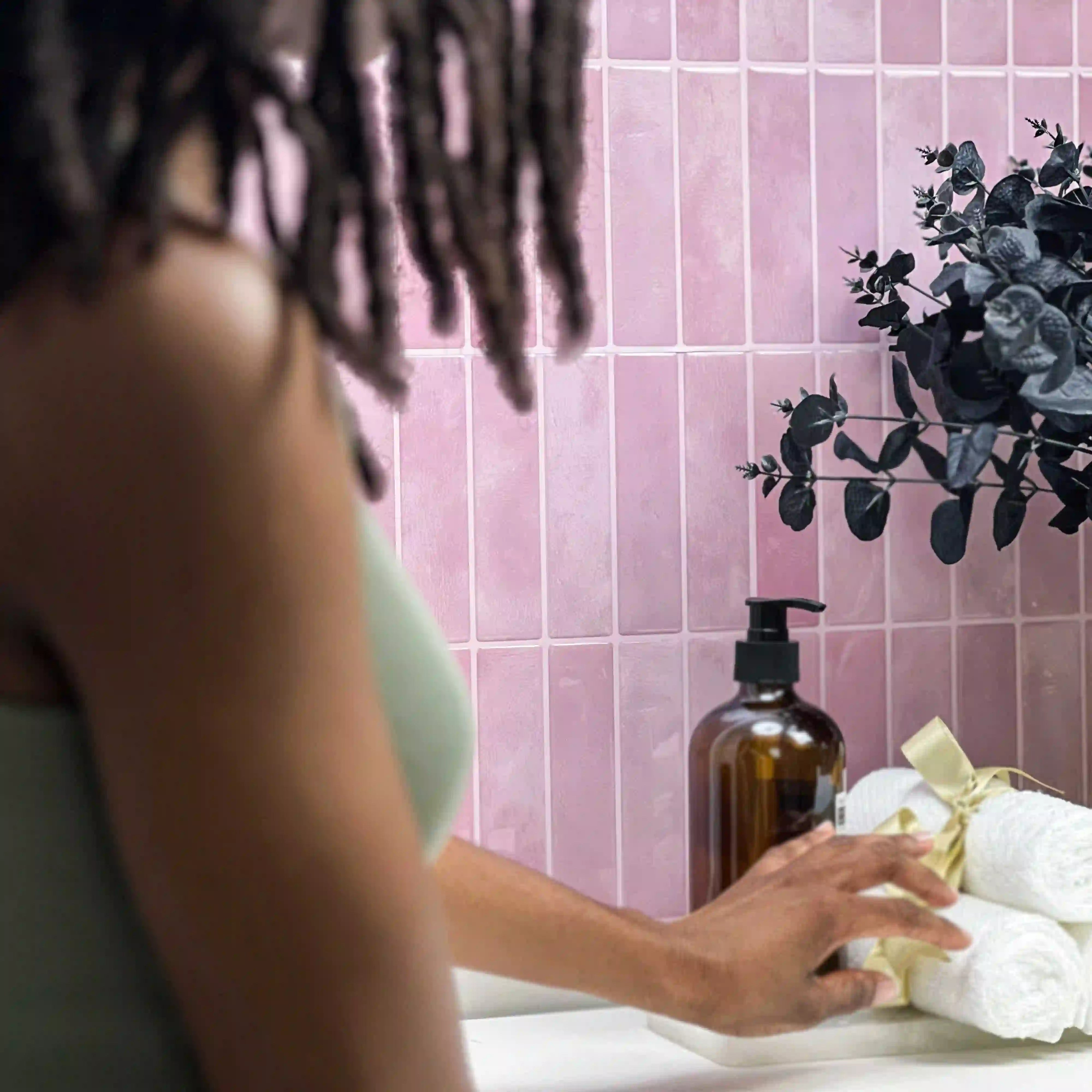
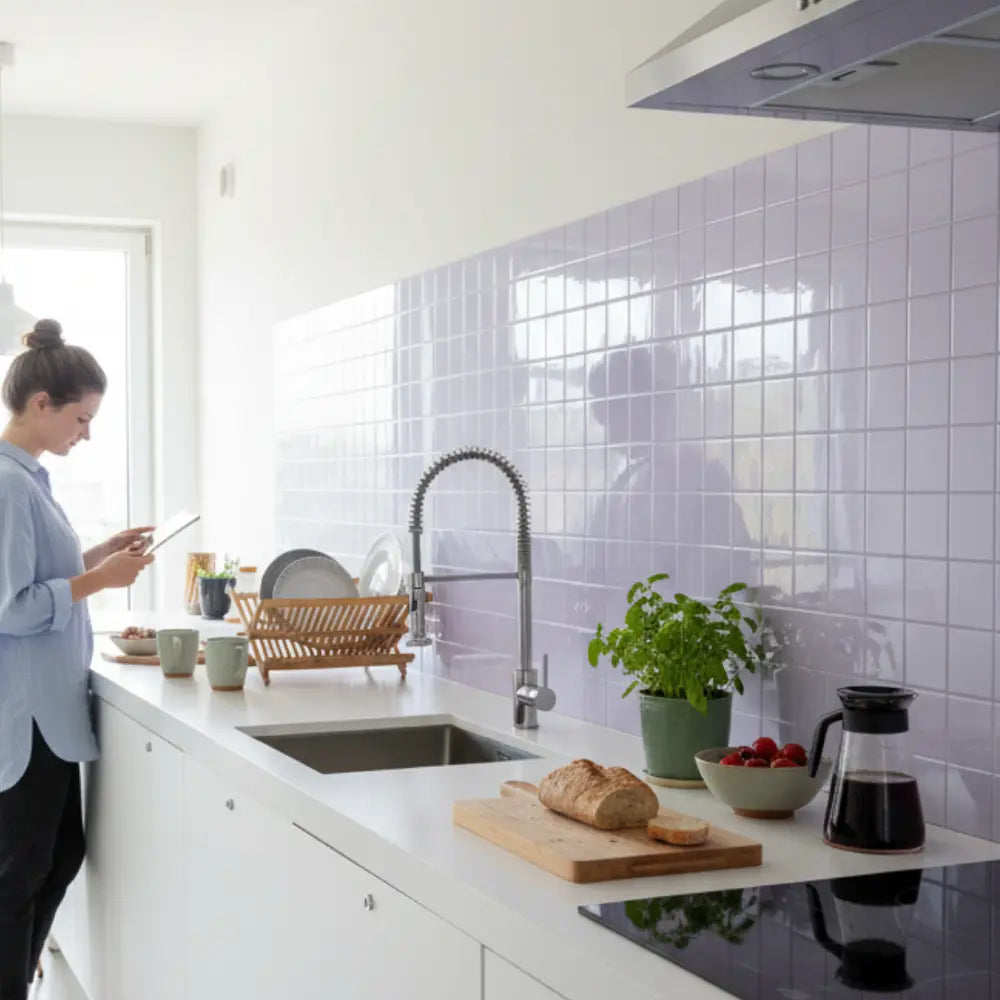
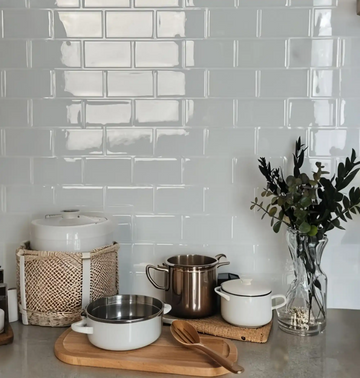
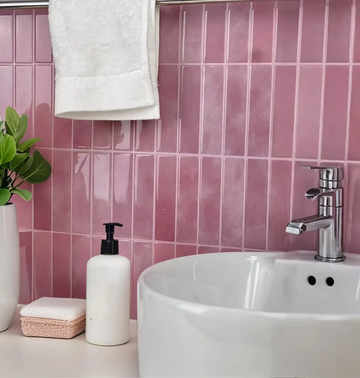
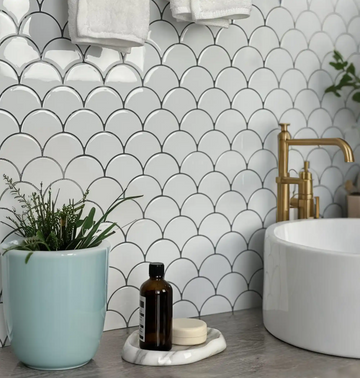
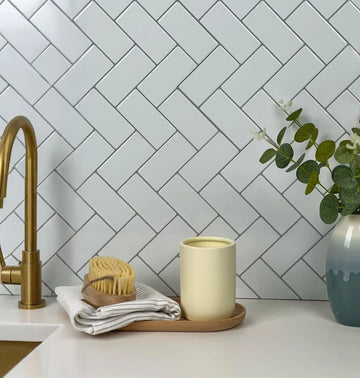



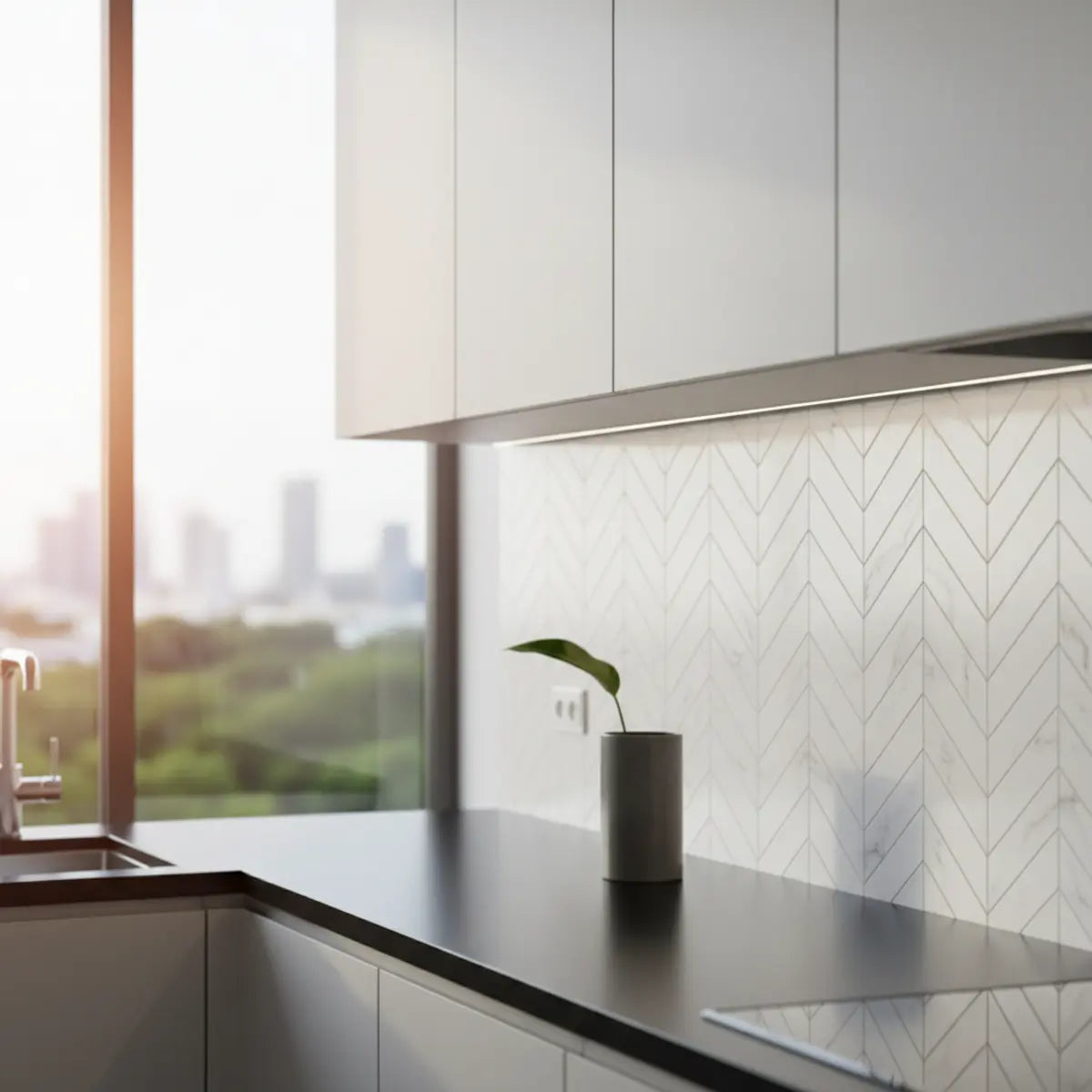
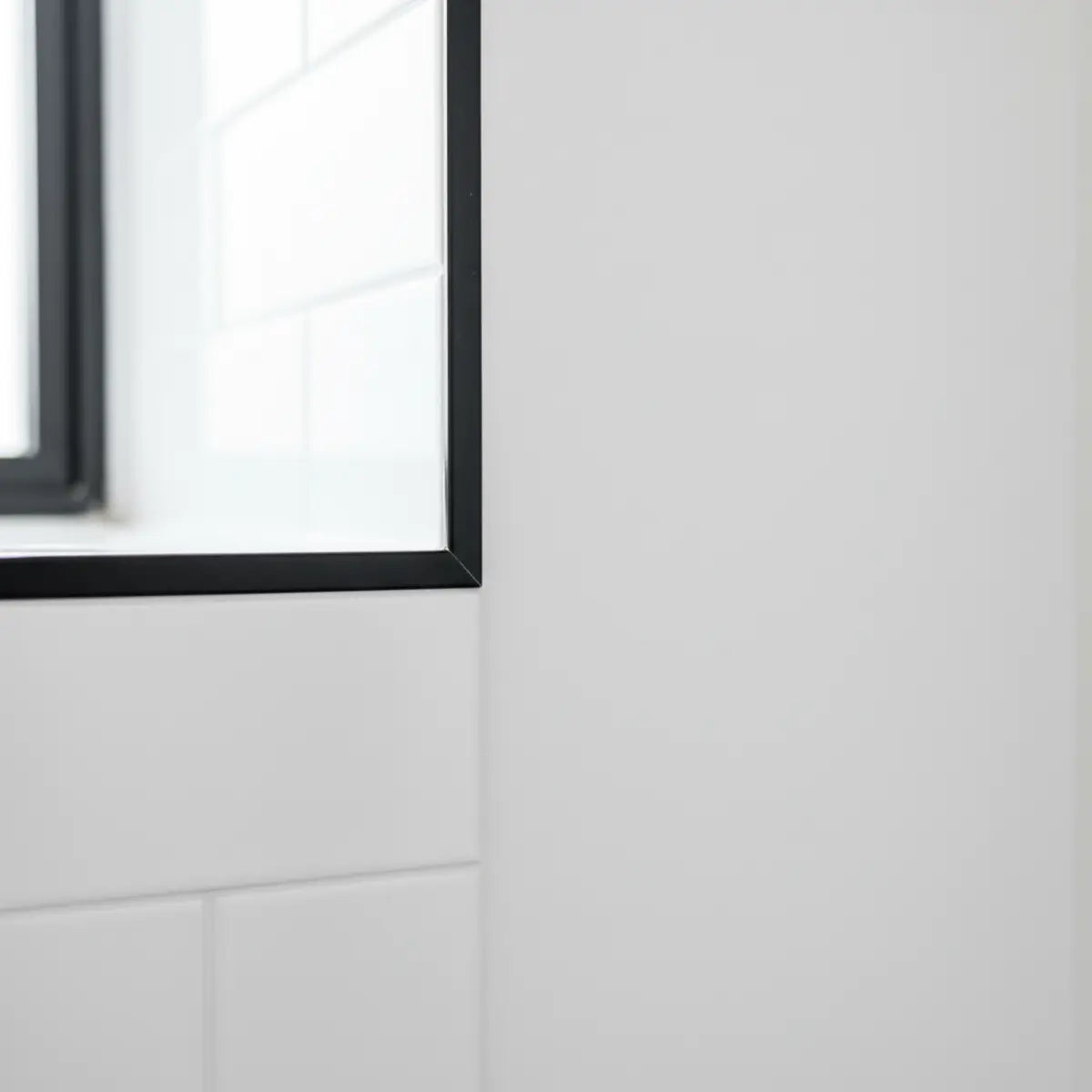
Hinterlasse einen Kommentar
Diese Website ist durch hCaptcha geschützt und es gelten die allgemeinen Geschäftsbedingungen und Datenschutzbestimmungen von hCaptcha.